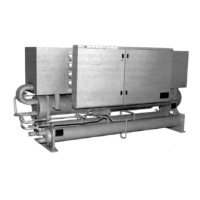Product Manual WHR-2 65
Application Data
Location and Space Requirements
The units are designed for indoor application and must be located in a space where the temperature
is 40°F (4.4°C) or above. Provide clearance of 2 to 3 ft. (609 to 914 mm) on each side and ends for
piping and to help when servicing unit.
Provide clearance at either end of the unit to permit cleaning of condenser tubes or for removal of
tubes from condenser or cooler (see dimensional data). If a door or window is provided at one end
of the unit, the tubes may be replaced through the opening provided.
Foundation
Mount the unit on a level concrete foundation. Floors must be strong enough to support the unit
weight. If necessary, use structural supports to transfer the weight of the unit to the nearest beams.
Vibration Isolation
Vibration mounts are recommended for upper floor installations or where compressor noises might
be objectionable (next to occupied spaces such as offices, meeting rooms, etc.).
Vibration eliminators may be used for water piping connected to the unit to avoid transmission of
water or pump noise into occupied spaces.
System water volume considerations:
All chillers need adequate time to recognize a load change, respond to the change and stabilize
without short cycling the compressor. The water volume in the system and the size of the piping
loop is a critical consideration. Good engineering practice is to have a minimum water volume of
seven times the flow rate (GPM) for comfort cooling applications. For process applications where
the load can change quickly, contact the factory for recommendations. A water storage tank
(provided by others) may be required to increase the system water volume in some systems.
Typical Chilled Water Piping
Flush the system water piping thoroughly before making connections to the unit evaporator. Install
a 40 mesh strainer in the return water line before the inlet to the chiller. Design the water piping so
the chilled water circulating pump discharges into the evaporator inlet.
Connect chilled water return water line to evaporator inlet connection. And the supply water line to
evaporator outlet connection.
Install a flow switch in the horizontal piping of the supply (evaporator outlet) water line.
Provide drain connections at low points in the system to permit complete drainage of the system.
Air vents should be located at the high points in the system to purge air out of the system. A vent
connection on top of the evaporator vessel allows air to be purged. Purge air from the water system
before unit start-up to ensure adequate flow through the evaporator.
Install pressure gauges in the inlet and outlet water lines to the evaporator. Measure pressure drop
through the evaporator to calculate proper flow. Vibration eliminators are recommended in both the
supply and return water lines.
Chilled water piping should be insulated to reduce heat loss and prevent condensation. Chillers not
running in the winter should have their water systems thoroughly drained to protect against
freezing. If the chiller operates year round, or if the system is not drained for the winter, protect the
outdoor chilled water piping against freezing. Wrap the lines with a heater cable and add proper
amount of glycol to the system to further protect the system.

